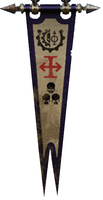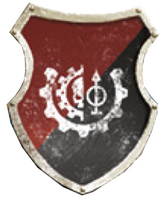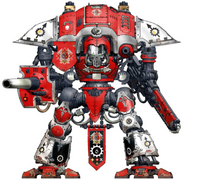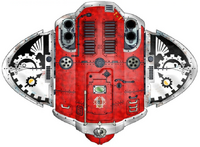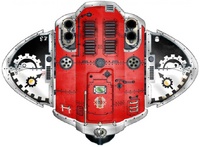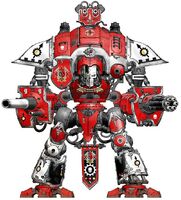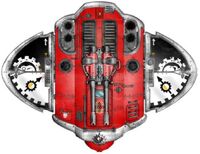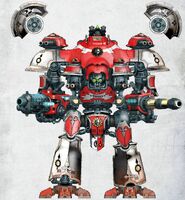"The enemy of my enemy is not my friend. They are carrion birds pecking at the scraps. They hold no honour within their soul. No sense of duty steels their spine. Inside them is nought but a desire for power, devoid of greater purpose and motivated solely by self-interest. They should be burnt to ash and scattered to the four winds, so none remember their name and none dare see them as hero nor martyr."
- — Pollicrux Ganrubar, Hero of Balltura, House Taranis (ca. M31)
House Taranis, also known as the "Knight Patriarchs" and among themselves as "Primus Inter Pares," is an Imperial Knight house of the Questor Mechanicus that has sworn direct fealty to the Adeptus Mechanicus. The first of the knightly houses to be established in the galaxy was that of House Taranis.
This truly ancient house predates any other by many hundreds of Terran years, for it was first founded on Mars during the Age of Technology alongside the technology of the Knight suit itself. As the industries of the Red Planet developed into a vast metropolis of technological mastery, so too did it evolve to become the first and foremost of the Forge Worlds, and the Knights of House Taranis were its guardians.
The STC technology supplied to many of the sublight Long March expeditionary fleets during Mankind's first expansion across the stars included designs for armoured suits of exo-armour based on those first developed to be used by the Knights of Taranis. When the Knight Worlds were first rediscovered during the Imperium's Great Crusade many thousands of standard years later, it is likely that the Mechanicum used their intimate knowledge of the Knight suits worn by House Taranis to help win the loyalty of many of those worlds as part of the Questor Mechanicus.
House Taranis was the first of the knightly houses to join the nascent Imperium. Having never been forced to survive on a frontier or build keeps against the dark void, they were more akin to the Adeptus Titanicus than their peers from the feudal Knight Worlds. However, the civil war that erupted on Mars during the Horus Heresy saw House Taranis suffer near-total losses at the hands of the Traitors.
As the internecine conflict drew to a close, only two Knights remained. Only incredible commitment, and the skill of Mars' Tech-priests, saw House Taranis survive its darkest hour, and rebuild to be stronger than ever before. This experience has stayed with the Knights of House Taranis; they believe the Omnissiah will always protect them, no matter how dark the hour, and it is this faith that has so emboldened them since the Great Rift yawned wide.
The motto of House Taranis is, "Honour thy Forge, Honour the Primus Ordinus."
House History[]
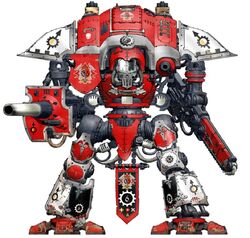
House Taranis colour scheme as displayed by a Knight Paladin.
House Taranis stands as first among equals amongst the esteemed and ancient ranks of the Questoris Familia, for within the veins of its Scions flows the blood of those who first strode the red sands of Mars from within the confines of a Knight armour. It was they who shaped the tenets and traditions upon which all Knight households were once built and they who first swore allegiance to the forge-lords of Mars.
From this heritage was born House Taranis and long has the household served the Red Planet, first againt the degenerate souls that sought dominion and death upon its sands and then across the stars, taking its place amongst the ranks of the Great Crusade.
Through every trial, those of House Taranis strive to uphold its ancient legacy, believing that to shirk in one's duty is to dishonour not just the household but all households that came after, defiling the countless sacrifices given over the millennia since the first Knight was forged.
Origins[]
Centuries before the Emperor conquered the warrior tribes of Terra during the Unification Wars of the late 30th Millennium, Mars was the centre for Mankind's mastery of technology. Among the wonders born from the forges of the Red Planet was the Knight suit, a weapon of such fearsome power as the mysteries of the Titans themselves.
House Taranis can trace its ancestry back to these times; its ancestors were the first to pilot the new and deadly Knight war machine, thousands of Terran years before the establishment of the Knight Worlds. In a time before the Throne Mechanicum contained the neural conditioning to create a Noble's sense of honour, loyalty and tradition, the pilots gave their allegiance to the Machine God and the ancient Mechanicum. It was only in the centuries after the bloody events of the Horus Heresy and the civil war on Mars (known as the Schism of Mars) that House Taranis rose to power.
It alone remained from the Knights of Mars in the wake of that terrible civil war, and the house would go on to form a core part of the armies of the reformed Adeptus Mechanicus and dedicate themselves completely to the worship of the Machine God during the Age of the Imperium. It was a path that would set them apart from the other knightly houses of the Imperium, even those dedicated to Forge Worlds or in sacred alliance with the Adeptus Mechanicus. The Knights of House Taranis stand among the forces of Mars, true servants of the Machine God.
Genesis of the Knight Suits[]
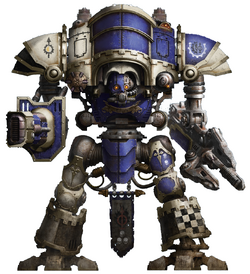
House Taranis Pre-Heresy colour scheme as displayed by the Questoris Knight Styrix Mors Iram.
The first Knight suit was one of the countless technological wonders created on Mars during the Age of Technology. The pioneering Nobles of House Taranis became the original Imperial Knights, and piloted the very first prototypes, fresh from the forges of Mars' industrial heart. Uniquely amongst the Nobles of the other knightly houses, however, the subtle, mind-altering technology was noticeably absent from the Thrones Mechanicum of Taranis' Knights.
This was in part due to the fact that the Martian Nobles who became the first Knights were already fiercely loyal to their Mechanicum overseers and House Taranis was an integral part of Mars' military infrastructure. The Imperial Knight Standard Template Constructs (STC) were upgraded to include the subliminal stimuli in preparation for Humanity's exodus across the stars, the better to prepare the Nobles who would be responsible for the protection of others.
Many of the Knight suits piloted by the Nobles of House Taranis were archaic compared to those of the "younger" houses, for they included the very earliest patterns and marks of Knight armour amongst their number. The destruction of so many Knights during the Horus Heresy saw this balance redressed, however, and the house was ultimately to be reborn with the very finest Knight suits at its disposal, as befitted the very first of the knightly houses.
Many of the Imperial Knights of House Taranis date back to the time of Taranis' renewal during the Heresy, each proudly emblazoned with the amended heraldry of their house. Never again has the strength of House Taranis been so sorely tested, for it returned from the precipice of annihilation greater than ever before.
Mars, Cradle of the Mechanicum[]
Located in the beating heart of the Imperium, Mars is the centre of the ancient Mechanicum and the present-day Adeptus Mechanicus and the first and greatest of its Forge Worlds. A sprawling world of ancient factories, towering hive cities and maze-like mines, it is home to billions of Tech-priests and servitors. In the skies above the planet, gigantic orbiting manufactoria burn bright with the fires of industry, void-lifts ferrying trillions of tonnes of cargo every solar day down to the surface or up into space.
Mars is also the port of the Battlefleet Solar, the largest of the Emperor's warship armadas, numbering thousands of vast and ancient battleships, each with the power to kill a world. In the centre of this teeming industrial planet, the Nobles of House Taranis hold council in spire palaces and void-station keeps. Unlike the Nobles of other worlds, those of House Taranis do not slavishly follow the ancient feudal traditions so common to those who sit on the Throne Mechanicum. Instead they are devotees of the Omnissiah, as much followers of the Machine God as the Tech-priests they call allies.
The root of this difference comes from their unique past, and the role they have played as part of the Adeptus Mechanicus for hundreds of centuries. The first Nobles of Mars were skilled pilots and favoured Enginseers, who understood their machines in ways their contemporaries could only hope to achieve.
As the Knight suits developed, so too did the Nobles, their personalities subtly changed by extensive neural connection to the Thrones Mechanicum. In time the growing sophistication of the Thrones and the Knights themselves meant that only those with a certain genetic makeup or biological heritage would make the best pilots. This led to the formation of knightly houses on Mars and preferential treatment for these special servants of the Machine God.
Great Crusade[]
The reputation of House Taranis is built as much upon its skill at arms and courage in the face of adversity as it is by the ancestry of its Scions. First amongst the Knight households to take its place within the expeditionary fleets, House Taranis brought battle to the galaxy's greatest threats, earning glories on hundreds of worlds from the Segmentum Solar to the distant fringes of known space.
Yet all was not pristine within the ranks of House Taranis and as its number swelled and spread across the galaxy, discord grew as greater numbers of its warriors served beyond the gaze of Mars. Year by year, conquest by conquest, the loyalties of House Taranis fragmented with many amongst its ranks holding duty to the Imperium above duty to Mars.
Horus Heresy[]
Up until the time of the Horus Heresy and the civil war on Mars these knightly houses had remained wholly part of the ancient Mechanicum, ranked alongside the high magi of each of the tech-disciplines. They would march to war beside the armies of the Mechanicum, their own livery dwarfed by the cog-skull of their tech-lords. Though the first signs of division between the houses and Mars were beginning to show, even in those early days, it would take a climatic event to throw it into stark relief.
The closing years of the Great Crusade were marred with increasing numbers of issued censures from the hierarchs of Mars to many amongst House Taranis, scolded for straying from complete devotion to the ruling fabricator-general. As the Horus Heresy began and Kelbor-Hal revealed his intentions to the Imperium, House Taranis was rife with discord and quickly torn asunder, its warriors turning against one another as each swore themselves into the service of those deemed worthy.
When the Great Betrayal tore Mars in two, many Knights sided with the Dark Mechanicum, falling to the whispered promises of the Chaos Gods. It was a war that devastated the Red Planet as Titans and Knights fought each other like vengeful gods over cities turned to flame and blood.
Those of House Taranis beyond the red sands were not spared death and destruction simply by their absence. With no guidance forthcoming from the war-torn surface of Mars, each fragment of House Taranis sought its own path. For most, this meant seeking new patrons, offering the services of the household in return for war materiel. Such benefactors stood on both sides of the civil war, and elements of House Taranis fought both for and against the Imperium, each believing they did right by the heritage of their household.
Across the galaxy, the fortunes of House Taranis waxed and waned, its numbers growing as new domiciles were founded, only to be decimated once more in the fires of war. By the end of the Horus Heresy, House Taranis had died a hundred deaths and the handful of Scions that remained faced an uncertain future that spoke of a galaxy devoid of its legacy.
In the end, only House Taranis Loyalists survived from among the Knights, its leaders swearing their fealty anew to the God-Emperor and the newly-appointed fabricator-general of Mars and father of the reformed Adeptus Mechanicus, Zagreus Kane. Since that time, House Taranis have been the favoured servants of the Machine God, never wavering in their loyalty or their dedication to its cause.
Knights of Mars[]
Though they bear the name of Noble and Knight, those of House Taranis do not follow the feudal ways of their kin. Having never been forced to survive on a Frontier World or build keeps against the dark void, they remain more akin to the Collegia Titanica than their peers from the Knight Worlds. Equally, they are not in thrall to the Throne Mechanicum like other Nobles, the subliminal neural conditioning that creates rigid traditions of the Knights absent from their own Thrones.
The Nobles of House Taranis do not share this secret with their brothers -- in their arrogance as the first and greatest of the knightly houses, they see their lack of conditioning as another hallmark of the Imperium's preeminent Knights. With the might of Mars behind them, the Taranis Nobles have some of the finest examples of the Knight suit at their command, including large numbers of rarer configurations like the heavy Knight Crusader and Knight Castellan patterns, each one tended to by scores of Sacristan-priests of unequalled skill. While they might not share the feudal and hidebound lives of other Nobles, they too understand that martial prowess, and oneness with their machines, can come only through constantly developing and honing their skills in endless practice in their Knight suits.
Across the ancient artificial landscapes and void gantries that cocoon the tiny Martian moon of Phobos, the Knights of House Taranis train alongside the Titan Legions in the specially-crafted proving grounds. Above the duelling war machines, the midnight sky is dominated by the huge red orb of Mars, the Forge World's millions of manufactoria and hive cities covering its surface in a burning spider's web of light.
Unequalled in the Imperium, the Adeptus Mechanicus' proving grounds use holo-arrays, augur echo masts and transmorphic terrain fields to replicate any kind of environment a Knight might have to fight in. Across battlefields choked in luminous mist, hard solar rain or coiling lightning wind, the Nobles pit their Knights against diverse enemy-constructs armed with an array of lethal weaponry.
Those Nobles that survive the proving grounds become the best of their kind, familiar with a wide range of the Imperium's myriad foes, from the cursed Warp constructs of the Traitor Legions to the living Bio-Titans of the Tyranid hive fleets. A master of countless kinds of warfare, a House Taranis Noble knows every potential limitation, strength and weakness of their Knight, eventually commanding the vast machines as if it were a second skin.
Psychosis-Neuracanium[]
The Ritual of Becoming is a hazardous process. Many of those who undertake its stresses do not survive, or if they do are rendered insensate or insane. For the Knight houses of most worlds these damaged family members are an embarrassment to be hidden away, the only hint of their existence the shuffling in a manor house attic or the rattling of chains from a castle dungeon. House Taranis, gifted with the learned presence of the Adeptus Mechanicus and an understanding of the Throne Mechanicum like no other, has a much more practical use for those incompatible with the device's delicate neural matrixes.
Known to the Tech-priests of Mars as the Psychosis-Neuracanium, Nobles that have failed the Ritual of Becoming and survived are still a valuable resource. They are highly trained warriors with an affinity for technology bred into them from birth. Their genetic make-up renders them natural leaders and perfect stock for the bionic enhancements of the Adeptus Mechanicus. Their flesh takes to metal and mechanical devices with an instinctive ease. That their minds have been ravaged by the Machine Spirits (artificial intelligences) of the Throne Mechanicum is of little consequence for their new roles.
Primarily, the Psychosis-Neuracanium are adapted for use as Skitarii captain-overseers. Their forebrains are implanted with emotive-selectors and memory-catheters to keep their rages and madness in check. Skull-plugs and flesh-connectors are then fused with weapon implants or auxiliary augur spines, further enhancing the Psychosis-Neuracanium's ability to perform a battlefield role.
The remains of their personalities are still present in their minds, even if it is only as a mere shadow of their former selves. The natural leadership instilled in them as Nobles makes them ideal candidates to become able commanders. A Skitarii's own machine brain and augmented psyche respond instinctively to the presence of a Psychosis-Neuracanium, their base Mechanicus indoctrination making them react swiftly and without question.
The families of House Taranis willingly give these broken sons and daughters to the attentions of the Mechanicus, on the promise that the regiments they lead, and the formations they fight in, will find a place at the side of the household Knights. Though the honour of commanding a Knight is denied to them, these damaged Nobles might still march with their brothers to war.
Notable Campaigns[]
- The Emperor Arrives on Mars (ca. M30) - Knight Taymon Verticorda, of House Taranis, is the first to encounter the Emperor of Mankind on His arrival at Mars. In his guise as the Omnissiah, the Emperor forges an auspicious alliance between Mars and the newly unified Terra in the Treaty of Mars that forms the backbone of His fledgling Imperium. Preparations are made for a great undertaking, the Great Crusade, to reunite the lost worlds of Mankind.
- Schism of Mars (007.M31) - When open civil war erupted all over the Red Planet as the civil war within the Mechanicum known as the Schism of Mars began, many Titan Legions and their vassal Knight households had already pledged their support to the Fabricator-General Kelbor-Hal and his co-conspirators of the Dark Mechanicum. House Taranis was rife with discord and quickly torn asunder, its warriors turning against one another as each swore themselves into the service of those deemed worthy. Those beyond the Red Planet were not spared from death and destruction simply by their abscence as each fragment of House Taranis sought its own path. During the subsequent Horus Heresy, elements of House Taranis found themselves fighting both for and against the Imperium.
- Defence of Ryza (012.M31) - Amongst the echelons of the Cult Mechanicus, Ryza stood second only to Mars in power and prominence by the end of the Great Crusade. Located within the Ultima Segmentum, its position was secured by its raw manufacturing power and its tactical location that, since Ryza first forged treaties with the Imperium, served to fuel the reach of the Great Crusade eastwards across the galaxy. Above all else, Ryza possessed unparalleled expertise in the engineering and production of plasma technology. In war, the luminaries of Ryza turned their efforts towards the continued support of the Imperium, refusing to be swayed by the honeyed promises of the Warmaster Horus and his emissaries. To this end they dispatched calls for aid, and offers in kind, to those forces scattered across the Ultima Segmentum and beyond. So it was that when the Warmaster bade his allies to seize the Forge World, it stood guarded not just by the formidable might of the Legio Crucius but the resurgent power of several other Legios and Knight houses. Amongst their number stood both House Taranis and House Zavora, ancient households bound to Mars since the Age of Strife, and both the Legio Honorum and Legio Osedax, all lent portions of their strengths to Ryza in accordance with treaties negotiated with their patron worlds. Yet, despite the might assembled upon the world, it paled in the face of the force marshalled against it, for some amongst the Dark Mechanicum, twisted kin of the Loyalist Mechanicum, dearly wished to claim the wealth and knowledge of Ryza as their own, bringing forth all manner of horrors to lay the world low. Though the war had ravaged much of the surrounding segmentum, Ryza had remained free of taint and conflict despite, or perhaps because of, the power it wielded. Yet its growing power had not gone unnoticed and, when time came for the Warmaster to assault the Segmentum Solar, he moved to enforce his will upon those who had escaped notice and might yet threaten his flanks as he marched upon the cradle of Humanity. The resurgent might of Ryza proved too powerful an enclave to ignore, for it served as a waystation for Imperial forces and, left unchecked, might yet unite resistance if the absence of the Warmaster's allies allowed his foes to rally. Seeking the elimination of the threat Ryza posed, the Warmaster bade his supporters amongst the Dark Mechanicum to fall upon the world, promising them vast rewards should they succeed. He cared little as to how they achieved such a goal and while the Warmaster desired only that the world be crippled beyond recovery, the Dark Mechanicum held more sinister ambitions for Ryza, seeking the creation of a new Hell-Forge for their profane experiments. It fell to Yuritus Omicron, Fabricator-Locum of Estaban VII, to conquer Ryza. In accordance with the Warmaster's wishes, Omicron assembled the might of the Legio Magna and Legio Vulturum, promises of vast riches awaiting their patrons should their aid bring success. With them came a decad of Titans from the Legio Mortis, their presence demanded by the Warmaster to ensure victory. In all, nearly 140 Titans were assembled, their gathered might a portent of doom for the world of Ryza. These Titan Legions were not to walk alone, for the Knight houses of Morbidia and Oroborn had been amassed alongside them.
- The Relief of Endeavour (012.M31) - The fall of Salvation Isthmus opened a path for the Traitors to fall upon all of Ryza. Splitting in two, the Traitor forces laid siege to both continents, still desiring to claim as much of the world intact as possible. In the days following the fall of the city of Endeavour, what Loyalist Titans were able moved to recapture the city. Few in number and drawn mostly from the Legio Osedax, they were faced with a wall of Titans standing atop the broken fortifications of the city. Endeavour itself was surrounded by barren plains that offered little cover, ensuring any assault upon the city would be in full sight of the Traitors and, against such numbers, the Legio Osedax had little chance of survival, even with the assembled might of House Taranis and Zavora by their side. Torn between duty and pragmatism, the commanders of the Legio Osedax moved to debate their options, proposing a retreat and the appointment of a new leader. This course of action was not condoned by the Knights of House Taranis and Zavora, for they were loathe to see another world they protected burnt in the fires of the Warmaster's ambition. As the sun rose on a new day, the Knight houses assembled and, as one, charged across the empty plain towards Endeavour, directly into the teeth of the Traitors' guns. Few of the charging Knights survived but those that did broke the Traitor line, using the confines of the streets to even the odds and bring down superior foes. Outside of the city, the Legio Osedax moved into action, hoping their numbers could tip the battle in the Loyalists' favour and push the Traitors from the city.
- Battle of Balltura (Unknown Date.M31)
- War of the Beast (544-546.M32) - The War of the Beast was an enormous Ork WAAAGH! of massive proportions, not seen since the Ullanor Crusade at the tail end of the Great Crusade. This invasion nearly brought the Imperium to its knees as the Greenskins threatened to invade the Throneworld itself. Humanity was only able to halt this advance utilising desperate measures and at great cost in both civilian and various military forces' lives, including those of House Taranis.
- Cold Trade Wars (Unknown Date.M41) - This campaign consisted of a series of battles that saw the Adeptus Mechanicus forces of an alliance of Forge Worlds defeat a large group of pirates operating from the Halo Stars. The Knights of House Taranis took part in the Cold Trade Wars and aided in the Forge World's victory over the pirates, by destroying the bases that were located on frozen moons and asteroid fields.
- Tarsok Incursion (230.M41) - Knights of House Taranis battled a daemonic incursion on the world of Tarsok V, taking the fight to the towering Great Unclean One that led the daemonic horde. Wading through a tide of Plaguebearers, Seneschal Halver's Knights advanced on the corpulent horror while billowing clouds of flies sizzled against their Ion Shields and formed drifts about their feet. The daemonic lord drowned one Knight in a tide of bile, and crushed two more beneath its weeping bulk. Yet the Knights' Reaper Chainswords carved through its rancid flesh and with a final, gurgling roar the Great Unclean One was banished back to the Warp. The remaining Daemons faded slowly from view, leaving the planet's surviving defenders to count the terrible cost.
- Battle of Ontoria XII (Unknown Date.M41) - This was a campaign that House Taranis took part in to defend the Imperial world of Ontoria XII against an unrecorded foe.
- Defence of Frontis (Unknown Date.M41) - The Defence of Fortis was a lamentable conflict that involved two Knight houses; House Taranis and House Griffith. Amid the ruins of an Imperial city, these two Knight houses came to blows over a vital supply drop. The Knights of House Griffith sought only to rearm their war engines for their next offensive, while the Knights of House Taranis coveted the war materiel for themselves. Exchanging insults at one another, soon the anger of the Knights of both households boiled over. The senseless battle that followed saw both households' Knights ravaged. Finally, the conflict was only resolved when the leadership of each Knight house agreed to a duel. The Knight Crusader Defiance, piloted by Lady Mikaela of House Griffith, strode towards the Knight Warden of House Taranis piloted by Baron Cavanix. The blood of her fellow Nobles was on the baron's hands. Powering up her guns, Mikaela unleashed the full firepower of her Knight as she closed with Baron Cavanix. Heavy Stubbers and Autocannons sprayed bullets across her armoured suit, her Avenger Gatling Cannon cycled through hundreds of rounds of ammunition, the shots driving deep craters into the baron's crimson armour. Her Battle Cannon roared time and again, high-calibre rounds smashing into the advancing Knight. Her Heavy Flamer engulfed him in fire. And still Baron Cavanix marched ever onwards. Lady Mikaela vowed that this Knight would fall and that he would pay for his treachery. As he broke into a run, Mikaela increased the speed of her Knight, racing towards him. The sound of the impact was defeaning. The city ruins shook as Mikaela battered the Knight Warden to the ground, her guns pummelling its armour, her feet lashing out as it tried to rise. Yet Baron Cavanix was not to be defeated. Reaching out with his Paragon Gauntlet, he grasped the Knight Crusader's leg and tore it clean from the hip. Mikaela roared with symbiotic pain and frustration as her Knight crumpled beneath her. She had failed her household. She had lost the supplies, the duel and her honour. Though House Taranis emerged victorious, it was a pyrrhic victory at best, as only the baron's Knight was left standing.
- 13th Black Crusade (999.M41) - During the closing years of the 41st Millennium, Abaddon the Despoiler launched his 13th Black Crusade. This massive conflict resulted in the largest mobilisation of both the Imperial military and the forces of Chaos since the Horus Heresy over ten millennia earlier. Abaddon's strategy was based around the concept of the "Crimson Path" -- to summon enough Daemons to the surface of the Fortress World of Cadia in order to overload the pylons that dotted the planet's surface and held back the tides of the Warp to create the Cadian Gate. Despite the Imperium's valiant efforts, Abaddon succeeded in his efforts by plunging one of the captured Blackstone Fortresses under his command into the surface of the doomed planet and utterly destroying Cadia. This resulted in a massive galaxy-wide tear in reality -- the Cicatrix Maledictum or "Great Rift," which extended from the Segmentum Obscurus all the way to the Eastern Fringe. With the barrier between the material unniverse and the Immaterium torn asunder, this allowed the forces of Chaos and their daemonic allies to pour forth in numbers never seen before, plunging the entire galaxy into chaos and bloodshed.
- Charadon Campaign (Unknown Date.M42 / 855-1058LRC) - Following the destruction of Cadia and the formation of the Great Rift, an event known as the Noctis Aeterna saw the light of the Astronomican blotted out and astropathic communication all but impossible across much of the galaxy. The Chaos Lord Typhus the Traveler, formerly of the Death Guard Traitor Legion, seized the opportunity to invade the Forge World of Metalica and plunged the Charadon Sector into war. In response, a massive Imperial Crusade consisting of a joint-Imperial force comprised of various military factions, including several Knight houses, was gathered to together to drive back the forces of Chaos. However, despite inflicting severe casualties upon the enemy, Typhus still managed to achieve his objective. By delivering his phage, the Forge World's Prime Industrial Cluster had become infected, creating mutated growths throughout Metalica's mechanical surface and corrupting its ancient data network. Despite their best efforts to eradicate the phage, the Metalican Mechanicus saw the reemergence of this dreaded corruption after supposedly eradicating it, and despite containing it, it appears anew -- again and again -- in an endless cycle of manifestation and purgation. While the region was declared pacified by the Imperium, Metalica was all but crippled while House Raven tragically had lost their homeworld. It would take many standard years of effort and many lives to truly reclaim the region. Abaddon's influence would continue to loom over the sector long after Typhus' departure.
Notable House Taranis Knights[]
- Ares Lictor - Questoris Knight Paladin of Lord Commander Taymon Verticorda, the co-commander of House Taranis, during the Great Crusade and the opening days of the Horus Heresy.
- Gladius Fulmen - Questoris Knight Paladin of Lord Commander Caturix, the co-commander of House Taranis alongside Lord Commander Verticorda, during the Great Crusade and the opening days of the Horus Heresy.
- Fortis Metallum - Questoris Knight Paladin of Preceptor Stator during the Great Crusade and the opening days of the Horus Heresy.
- Equitos Bellum - Questoris Knight Paladin of Rav Maven during the Great Crusade and the opening days of the Horus Heresy. This honourable mount had a host of battle honours earned in the earliest days of the Great Crusade. It had fought the enemies of the newborn Imperium beneath a dozen different skies, and even marched alongside the Salamanders Legion of Primarch Vulkan. The design of a firedrake carved into the skull-cockpit of the Knight recalled that campaign, and Maven never tired of telling the stories of that glorious ride into battle.
- Pax Mortis - Questoris Knight Paladin of Leopold Cronus during the Great Crusade and the opening days of the Horus Heresy.
- Blade of Mars - Knight Errant of Sir Xantek.
- Giant-Killer - Knight Errant of Sir Vagoran.
- Omnissiah's Fury - Knight Paladin of Sir Soberan.
- The Red Doom - Knight Paladin of Sir Ulantor.
- Red Might - Knight Crusader of Sir Drantar.
- Devastation Unbridled - Knight Castellan of Sir Archimaxes.
- Red Jackal - An Armiger Warglaive piloted by Sir Thassor.
- Hastam Gloriae - Hastam Gloriae or "Spear of Glory," was a Cerastus Knight-Lancer of House Taranis depicted below in the traditional Pre-Heresy colours of the household used before the Storm of Endeavour campaign during the Defence of Ryza.
- Mors Iram - Mors Iram, depicted above in the traditional Pre-Heresy colours of the household shortly before the start of the Schism of Mars, was a Questoris Knight Styrix often paired with allied Titan maniples because of its effectiveness in degrading Titan void shields.
Notable Personnel[]
- Cheops Taranis - Cheops Taranis was the founder of House Taranis, who united the two largest Knight spearhead formations on Mars in the 25th Millennium by besting his rivals.
- Chefren Taranis - In 199.M32, Chefren Taranis led the charge in his Knight suit against an invading Ork horde. He single-handedly decimated the warlord's bodyguard of Ork Nobz and killed the Greenskin leader. The Taranis coat of arms was changed at this time in recognition of such a valorous deed.
- Ankenaten Taranis - In 523.M35 the rule of the Princeps Ankenaten Taranis marked a new age of independence for his house. He forged an alliance with the Fabricator-General of the Mechanicus that saw House Taranis gain rights of authority within the armies of Mars.
- Lord Commander Taymon Verticorda - Pilot of the Questoris Knight Paladin Ares Lictor, Lord Commander Taymon Verticorda was the first to encounter the Emperor after on His arrival on Mars in the late 30th Millennium. After Verticorda bent his knee to the Emperor over two hundred Terran years before the outbreak of the Horus Heresy, the joint commanders of the Knights of Taranis served as the Princeps Conciliatus between the warrior orders of Mars. It was their job to ensure that gatherings were conducted in a manner befitting the most ancient warrior guilds, that tradition was upheld and honourable discourse permitted. A hunched and ancient warrior, Verticorda was aged and revered for his wisdom. Alongside his fellow master of the Knights of Taranis, Lord Commander Caturix, during the Great Crusade and the early days of the Horus Heresy the twin commanders complemented one another's tactics and leadership styles.
- Lord Commander Caturix - Caturix was the pilot of the Questoris Knight Paladin Gladius Fulmen. Alongside his fellow Lord Commander, Taymon Verticorda, Caturix and his counterpart were known as leaders whose shared command blended the warrior's heart with the diplomat's cool. He was the fellow master of the Knights of Taranis during the Great Crusade and the opening days of the Horus Heresy. Caturix was beloved for his fiery passion, which complemented his fellow commander's more cautious temperament.
- Preceptor Stator - Stator was the pilot of the Questoris Knight Paladin Fortis Metallum during the Great Crusade and the opening days of the Horus Heresy. Stator died at the defence of Magma City during the Schism of Mars.
- Raf Maven - Maven was the pilot of the Questoris Knight Paladin Equitos Bellum during the Great Crusade and the opening days of the Horus Heresy. Maven was a valiant Knight who not only survived the tragic events of the Schism of Mars, but went on to rebuild and rule House Taranis as the new Lord Commander of the house after the disastrous civil war on Mars and the deaths of Verticorda and Caturix.
- Leopold Cronus - Cronus was the pilot of the Questoris Knight Paladin Pax Mortis during the Great Crusade and the opening days of the Horus Heresy.
- Soberan - Soberan was the pilot of the Knight Paladin Omnissiah's Fury. Soberan is remembered on Mars for the service he rendered to Magos Explorator Gaeren and the Veiled Fleet. He followed the magos on his journey through the Veiled Region, defending his dig sites from hostile natives and Eldar raiders.
- Ulantor - Notable pilot of the Knight Paladin The Red Doom, Ulantor is renowned for his great victory against the armies of the Dark Mechanicum on the planet of Hyperior III.
- Vagoran - Notable pilot of the Knight Errant Giant-Killer, Vagoran is remembered by his house for his valorous actions during the Battle of Dusken V, where he gained his first laurel-cog in recognition of his heroic deeds. Fighting against an army of Chaos Cultists and their daemonic allies, Vagoran fought against a Greater Daemon, and managed to fire his Thermal Cannon point-blank into the daemon's chest, sending it screaming back into the Warp with its many daemonic children banished along with it.
- Xantek - Notable pilot of the Knight Errant Blade of Mars, Sir Xantek is one of the Phobos proving grounds' combat instructors. This Noble understands his Knight like few others, and works closely with the Sacristans to ensure it remains in perfect fighting form. On the fields of Gorgoth, a world that had been forsaken long ago by humanity, Xantek was sent by the Adeptus Mechanicus to help in the recovery of ancient components from an ancient Legio Titanicus manufactorum. When the Adeptus Mechanicus reclamation force arrived, they encountered the Legio Mortis Traitor Titan Legion and their Chaos allies. In the ensuing conflict, though Xantek and his lance-brothers fought with valour, they were outmatched. Xantek had suffered grievous wounds and was considered no longer fit to serve within the Legio Titanicus. Through years of pain and training, Xantek risked death and madness and had his neural plugs removed. After he allowed his ravaged brain time to heal over a number of years, he underwent the process of implantation once more. One of the few Nobles to ever undertake the Ritual of Becoming a second time, Xantek faced his nightmares as he returned to the Throne Mechanicum. When he emerged from the ritual it was as the Noble he had once been, his honour and skills at long last restored. He believes himself the embodiment of his house's ability to rise again from darkness, and his faith is fervent indeed.
- Drantar - Notable pilot of the Knight Crusader Red Might which has been assigned as support to the Skitarii of Mars. Throughout a solar decade-long search for archeotech, Sir Drantar has travelled to distant stars and fought alongside his Adeptus Mechanicus allies, according to their demands. Under Drantar's guidance, Red Might has ploughed through Greenskins, fended off Aeldari raiders and provided both covering fire and anti-armour support for Mars' Skitarii Legion. Drantar's secondment to the Skitarii has been lengthy, but is not considered permanent.
- Archimaxes - Sir Archimaxes rules over Hydraulach Point. This armoured keep overlooks the southern reaches of the Mare Erythraeum on Mars, and is intended as a shield against the predatory Battle-Servitors that periodically range out of their hunting grounds to threaten the manufactoria beyond. Archimaxes stands his vigil alone, and is happy to do so, for he is a solitary being who prefers the company of machines to that of living creatures. Archimaxes is only truly content when enthroned within his mighty Knight Castellan, Devastation Unbridled, hunting down and eliminating corrupted, ancient Servitor-monsters the size of dropships. When he is called to war by the Princeps of House Taranis, Archimaxes speaks little to his comrades. Yet they are ever grateful for his taciturn presence, for he is diligent in his efforts to shield them from harm, and merciless in his persecution of the enemy's largest and most monstrous beasts.
- Thassor - Sir Thassor considers himself an exterminator of unclean engines. His Armiger Warglaive, Red Jackal, has a predatory Machine Spirit, and together the two of them run down and execute Traitor tanks without mercy.
House Strength[]
The long heritage of House Taranis, combined with its status as the preeminent Knight household of Mars, ensured that its strength was greater than any other recorded household within the Imperium, bar perhaps that of House Raven. Indeed, long before a codified measure of household strength was implemented, the strength of newly-discovered Knight houses was measured against that of House Taranis to determine their worth and capability.
By the end of the Great Crusade, House Taranis proved capable of fielding nearly 600 functional Knight armours of all manner of patterns and armaments, granting it the designation of a Primaris (Maxis)-grade household. As the first among Knight households, House Taranis was forever chosen to test innovations forged upon Mars, and it was upon the recommendation of its Scions that such developments would be disseminated amongst the Questoris Familia.
This esteemed position enabled House Taranis to field considerable quantities of rarer pattern Knights, laying claim to dozens of Acastus Knight Porphyrions, Cerastus Knight-Atrapos and the Knight Magaera and Knight Styrix, where lesser households owned but a handful.
Before the events that initiated the Schism of Mars, House Taranis possessed four dozen Knight Styrix pattern armours including the Thought of Innocence. Though designed primarily as an anti-infantry Knight, the advent of the Horus Heresy saw the Knight Styrix develop a new niche in the unfolding nature of the conflict to come. The deflagrating properties of the Styrix's Volkite Chieorovile proved effective at overloading void shields, the rapid thermal increase straining the reactors of any Titan it struck. This led to the Knight Styrix being increasingly paired with heavier Titan maniples in order to shatter the void shields of opposing god-engines and leave them vulnerable to allied guns.
The legacy of House Taranis proved just as valuable an asset of the household's martial prowess. Often, detachments of House Taranis Knights were assigned to those who Mars sought to foster bonds with, be that an expeditionary fleet, Titan Legion or far-flung Forge World.
Intended to cement the power and reach of the Red Planet, the secondment of much of House Taranis' strength proved useful to ensure the household's continued survival during the Horus Heresy, the cataclysmic losses of one fragment meaning nothing to those deployed elsewhere.
House Allies[]
Loyalist Titan Legios[]
House Appearance[]
House Colours[]
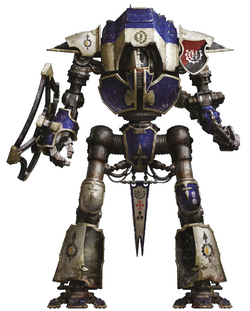
House Taranis Pre-Heresy colour scheme, as displayed by the Cerastus Knight Lancer Hastam Gloriae during the Horus Heresy.
Pre-Heresy[]
Before the Horus Heresy, House Taranis used blue and white as their primary colours. Though red and silver were the colours traditionally associated with ancient Mechanicum vassal Knight houses, Taranis bore their own heraldry in recognition of the legacy of their ancestors as forefathers to all of the Knight households in existence.
At times, House Taranis Knights would temporarily don the colours of their liege lords when serving as protectors of distinguished Mechanicum personnel. However, as the events of the Horus Heresy dragged on and House Taranis became ever more reliant on aid supplied by the Forge Worlds to survive, more and more of their number decorated their armour in Mechanicum red in recognition of the debt they owed to their saviours.
Post-Heresy[]
Following the events of the Horus Heresy, the loyalties of House Taranis long stood in doubt, for numerous accounts spoke of Knights bearing the livery of House Taranis marching against one another beneath different banners, the scattered remnants of the household spilling its own blood in service to warring powers.
Such livery underwent stark changes during the Horus Heresy, with the traditional blue of House Taranis eventually giving way to the red of a bonded Mechanicum household, as the Knight house became reliant upon the largesse of numerous Forge Worlds to survive the bitter conflict.
With such strong connections to the Forge World of Mars, House Taranis has ever borne the red of the Adeptus Mechanicus as its livery since the end of the Horus Heresy.
House Arms[]

House Taranis iconography (ca. M30-M31).
The name of House Taranis is heavy with the weight of deeds performed in an ancient time steeped in infamy. Yet even before the dark days of the Horus Heresy, House Taranis bore the honour of being the first knightly house ever raised. In the 25th Millennium, Cheops Taranis, the house founder, united the two largest Knight spearhead formations on Mars by besting his rivals.
The house emblem at this time was two spearheads on a red field. By the time House Taranis was incorporated into the burgeoning Imperium of Man, they utilised a differen emblem, which took the form of a black half-skull centred within a half-cog. To this symbol's immediate left was another in the form of an arrow bisecting a circle and pointing upwards. This was the ancient astrological symbol utilised to represent the planet Mars.
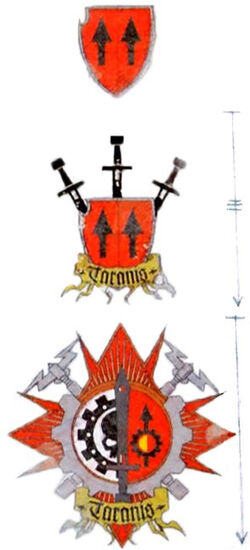
An example of the genesis of House Taranis's iconography over the millennia
These symbols were indicitive of House Taranis' stalwart dedication and unfettered loyalty to Mars and its Mechanicum overlords.
In 199.M32, Chefren Taranis led the charge in his Knight suit against an invading Ork horde. He single-handedly decimated the Warlord's bodyguard of Ork Nobz and killed the Greenskin leader. The Taranis coat of arms was changed at this time in recognition of such a valorous deed, which now included the house's name on a scroll centred below the shield, and three swords behind the shield.
In 523.M35 the rule of Ankenaten Taranis marked a new age of independence for his house. He forged an alliance with the fabricator-general that saw House Taranis gain rights of authority within and over the military forces of Mars. Indeed, the crest of House Taranis bears the stylised Cog Mechanicum of Mars at its centre, for the Red Planet of the Adeptus Mechanicus is its homeworld –- a fact that grants it peerless status amongst the other knightly houses of the Imperium.
House Taranis has ever proudly borne the red of Mars as its livery since the Horus Heresy, though this symbolic field has since been adopted by many of the other knightly houses that are directly aligned to the Adeptus Mechanicus as members of the Questor Mechanicus.
The sword that divides the crest of House Taranis from the demi-cog symbol of the reformed Adeptus Mechanicus was added in the wake of the Horus Heresy. Raf Maven, a valiant Knight who not only survived, but went on to rebuild and rule House Taranis after the disastrous civil war on Mars, insisted on adding the emblem in honour of his kinsmen who died in the bitter fighting. This legacy combined with its illustrious homeworld ensures that Taranis remains the foremost of the knightly houses in the 41st Millennium.
Livery and Honour Markings[]
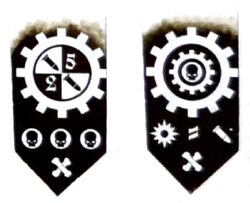
The banners of the Adeptus Mechanicus-aligned House Taranis.
Questor Mechanicus knightly houses dedicated to the Machine God are less predisposed to tolerate personal heraldry; this does not, however, preclude individual differences. These knightly houses often use white and black on their Knight's main carapace. Also of note is the common black-and-white half toning of the Knight's faceplate, an homage to the Opus Machina of the Adeptus Mechanicus.
House Taranis follows standard knightly convention for the design of its banners. Of note is their use of the cog symbol that sits between the full house crest and their honour markings. These large icons are highly formalised. The exact composition has meaning and can denote rank.
On the left is the banner of Sir Xantek. His recognition numbers (two of five) are ensconced within the test-pattern layout of the techno-magi. Sir Soberan, whose icon is on the right, has a double cog. This represents his Knight suit's initiation into the Cult Mechanicus to the second degree.
Sources[]
- Adeptus Titanicus: The Horus Heresy - Loyalist Legios (Specialty Game), pp. 24-27
- Codex: Adeptus Mechanicus (8th Edition), pp. 30, 57
- Codex: Imperial Knights (6th Edition) (Digital Edition), pp. 41, 72, 76-81, 102, 105
- Codex: Imperial Knights (7th Edition) (Digital Edition), pp. 58-59
- Codex: Imperial Knights (8th Edition), pp. 44-45
- The Imperial Knights Companion (6th Edition), pp. 15, 17, 23, 80-89
- White Dwarf (July 2018), "Battle Report: A Gauntlet Thrown Down," pp. 44-59
- Mechanicum (Novel) by Graham McNeill


